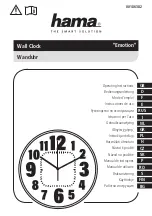
another vintage display technology, the
cathode
ray gun
into a discrete counting device. The E1T
uses a cathode ray and some neat tricks to display
a green line in 10 positions, each cunningly
numbered from 0 to 9. These were used in early
counters (such as the one pictured on the right). A
far more detailed explanation of how to electrically
drive an E1T can be found later on in this
document. There are also some great resources on
the web for history and data about the E1T.
Anatomy of a Fortress
The clock consists of the following components;
•
Six E1T tubes encased with raked cast acrylic light guides.
•
Two acrylic light guide rod colons.
•
PIR - so the clock can go to ‘sleep’ if no-one is in the room to bask in its beauty.
•
Rotary encoder - to select the different ‘faces’ to the clock and also to adjust the volume.
•
Infrared remote sensor
•
Two high quality downward firing speakers - the Fortress is capable of using .WAV files to
play chimes and audio.
•
SD Card - this contains all the face file descriptors (Nuggle programs), audio files, chimes ,
system files and
system.ini
file.
•
A removable plate at the rear to access both the SD card and the programming port on the
CPU board.
•
A GPS/WiFi antenna connector
•
PSU Input hole (12V DC rated at a
minimum
•
A case top/cover for the clock
https://en.wikipedia.org/wiki/Cathode-ray_tube
http://www.tube-tester.com/sites/nixie/different/e1t-tubes/E1T_philips/e1t-phil.htm; https://www.dos4ever.com/E1T/E1T.html
As interesting as the E1T is as a piece of vintage CRT technology, we thought we’d spruce things up with a little extra bling….which you
can turn off if you so desire!
PIR - Passive InfraRed sensor.
For clear acrylics, these are IR transparent, but opaque materials and aluminium cases have a cut-out for the IR receiver.
quite amusing
.
The clock doesn’t require a continuous 5A input, but upon startup the heaters require quite a bit of
juice
to warm up. This is mitigated a lot
by the slow startup implementation in the clock hardware, but current spikes of approximately 3A are not uncommon from a cold start.
Page 3
Version 1.0
Copyright Grahame Marsh/Nick Stock 2019
Left:
PIR,
Middle:
Rotary encoder,
Right:
InfraRed
receiver
Left:
PSU input,
Middle:
Access plate for SD and CPU
socket,
Right:
GPS/WiFi antenna connector
Содержание An E1T Timepiece
Страница 79: ...Fortress How It Works Board Schematics and Function Page 79 Version 1 0 Copyright Grahame Marsh Nick Stock 2019...
Страница 82: ...Page 82 Version 1 0 Copyright Grahame Marsh Nick Stock 2019 1 1 SAM3X8C schematic...
Страница 108: ...Page 108 Version 1 0 Copyright Grahame Marsh Nick Stock 2019...
Страница 109: ...Page 109 Version 1 0 Copyright Grahame Marsh Nick Stock 2019...
Страница 110: ...Page 110 Version 1 0 Copyright Grahame Marsh Nick Stock 2019...
Страница 120: ...E1T Data Sheet Page 120 Version 1 0 Copyright Grahame Marsh Nick Stock 2019...




































